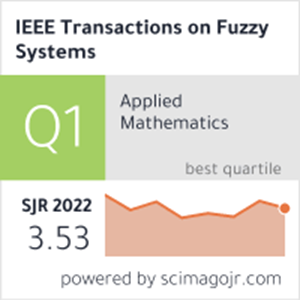Robust Jointly Sparse Fast Fuzzy Clustering via Ternary-Tree-Based Anchor Graph
IF 10.7
1区 计算机科学
Q1 COMPUTER SCIENCE, ARTIFICIAL INTELLIGENCE
引用次数: 0
Abstract
Traditional partition-based fuzzy clustering algorithms are widely used for revealing possible hidden structures in data. However, high computational cost limits their applications in large-scale and high-dimensional data. Moreover, most fuzzy clustering algorithms are sensitive to noise. To tackle these issues, a robust jointly sparse fast fuzzy clustering algorithm via anchor graph (RSFCAG) is proposed and analyzed in this article. Specifically, we first propose a fast k-means method integrated shadowed set and balanced ternary tree, which serves as a fast hierarchical clustering approach by partitioning every cluster into three subclusters at each layer (3KHK). 3KHK can quickly obtain the anchor set and its optimization is solved fast by the simplex method, which also captures the ambiguity and uncertainty between clusters in large-scale clustering tasks. Second, a similarity matrix learning approach based on possibilistic neighbors is further proposed to get a robust similarity graph, which strengthens the ability of fuzzy clustering to handle large-scale data. Furthermore, the orthogonal projection matrix is integrated into the RSFCAG framework to transform the original high-dimensional space into low-dimensional space. Finally, the通过基于三元树的锚图进行稳健的联合稀疏快速模糊聚类
传统的基于分区的模糊聚类算法被广泛用于揭示数据中可能隐藏的结构。然而,高昂的计算成本限制了它们在大规模和高维数据中的应用。此外,大多数模糊聚类算法对噪声都很敏感。针对这些问题,本文提出并分析了基于锚图的鲁棒联合稀疏快速模糊聚类算法(RSFCAG)。具体来说,我们首先提出了一种结合阴影集和平衡三叉树的快速k-means方法,该方法通过在每层将每个聚类划分为三个子聚类(3KHK),作为一种快速的分层聚类方法。3KHK可以快速获得锚集,并通过单纯形法快速求解其优化问题,该方法还捕获了大规模聚类任务中聚类之间的模糊性和不确定性。其次,提出了一种基于可能邻域的相似矩阵学习方法,得到鲁棒的相似图,增强了模糊聚类处理大规模数据的能力;再将正交投影矩阵集成到RSFCAG框架中,将原有的高维空间转化为低维空间。最后,将$L_{2,1}$-范数损失和正则化集成到联合算法RSFCAG中,采用分块坐标技术进行优化求解,增强了模糊聚类过程的鲁棒性和可解释性。实验结果证明了该方法在大多数基准数据集上的有效性和高效性。
本文章由计算机程序翻译,如有差异,请以英文原文为准。
求助全文
约1分钟内获得全文
求助全文
来源期刊

IEEE Transactions on Fuzzy Systems
工程技术-工程:电子与电气
CiteScore
20.50
自引率
13.40%
发文量
517
审稿时长
3.0 months
期刊介绍:
The IEEE Transactions on Fuzzy Systems is a scholarly journal that focuses on the theory, design, and application of fuzzy systems. It aims to publish high-quality technical papers that contribute significant technical knowledge and exploratory developments in the field of fuzzy systems. The journal particularly emphasizes engineering systems and scientific applications. In addition to research articles, the Transactions also includes a letters section featuring current information, comments, and rebuttals related to published papers.
 求助内容:
求助内容: 应助结果提醒方式:
应助结果提醒方式:


